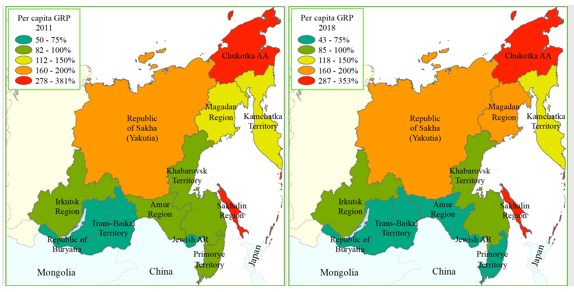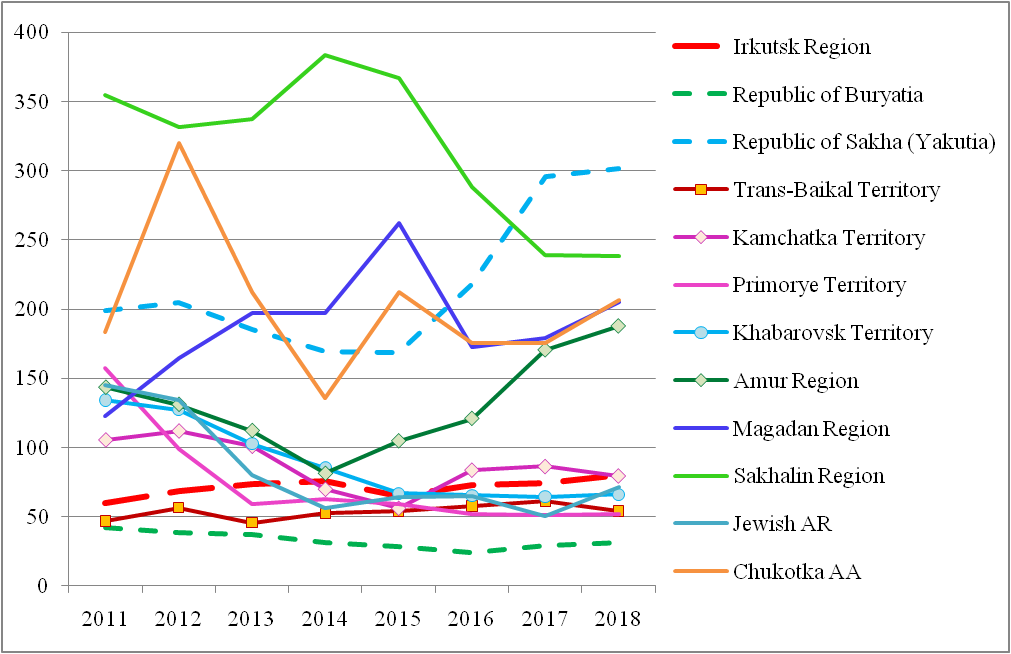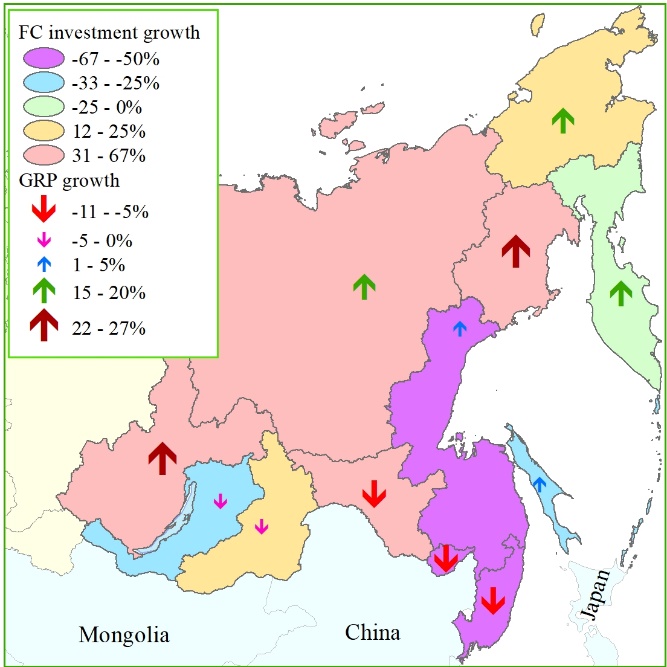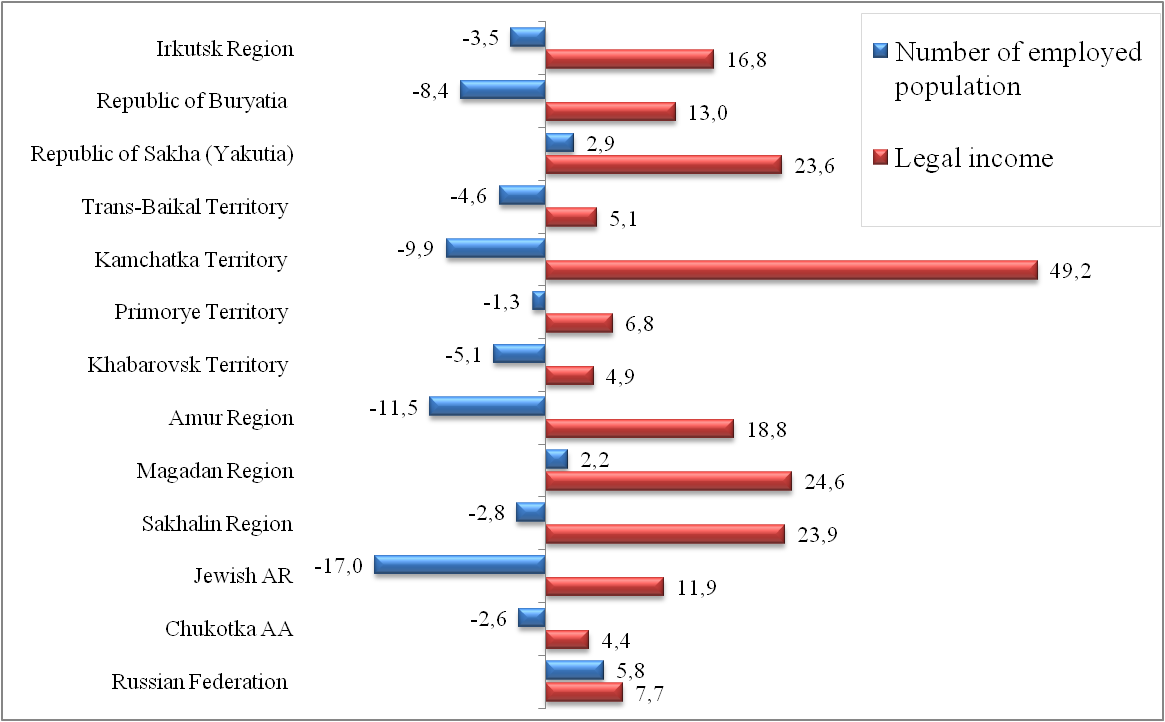Abstract
This article examines whether the hopes for accelerating the Transbaikal Territory and the Republic of Buryatia development are justified in connection with the decision taken in 2018 to include them in the Far Eastern Federal district. This means that these regions became the subjects of an innovative institutional environment. For this purpose, an empirical analysis of economic growth dynamics, investment flows, and regional wage funds are being conducted from 2011 to 2018. It is time when the factors related to the development Program of the Far East and the Baikal region until 2030 have already started to work. It is shown that the dynamics is not always marked by significant positive changes that could be associated with the presence of the "Far Eastern preferences". A similar conclusion can be drawn concerning the legal income of citizens. Thus, we have no grounds to conclude that the Far East's institutional transformation during the period of high instability associated with economic shocks after 2014 played a positive role in terms of economic growth and welfare. However, the observed dynamics of investment in fixed capital and foreign direct investment in the Far Eastern border regions are more favorable than in the Baikal region. This factor leaves hope for a positive impact of the "Far Eastern status" for the Republic of Buryatia and the Transbaikal Territory.
Keywords:
Introduction
The inclusion of the Transbaikal Territory and Republic of Buryatia in the Far Eastern Federal district (FTFD) at the end of 2018 is assessed ambiguously by experts. This is caused by expectations of additional transfers from the Federal budget, and favorable investment conditions, the growth of the regional economies, and welfare (Izotov, 2017; Minakir & Prokapalo, 2018), contribute to the achievement strategic goals (Zubarevich, 2019). The prospects for participation in national projects also support these hopes. However, national projects are related to medium-term goals, and the corresponding plans are being developed until 2024. Even if a significant "breakthrough" can be achieved during this period, the stability of positive trends must create conditions for a long-term endogenous growth, including an institutional environment of appropriate quality. Therefore, it is doubtful that the inclusion in the FEFD "automatically" will bring fast and significant advantages.
Problem Statement
The analysis proposed in this paper is intended to assess the comparative dynamics of development of the Eastern regions after 2011, after the formation of new development institutions in the Far East. Perhaps its results will make it possible to avoid, on the one hand, the repetition of old mistakes, and to show the necessary directions for institutional transformation in the future, on the other. The analysis was carried out not only for Republic of Buryatia and Transbaikal Territory, but also for Irkutsk Region, which is part of the Baikal region. It was important to make a comparison with the regions of the Far Eastern Federal district, which are located in more or less comparable socio-economic and natural-geographical conditions, so its Southern border regions were chosen: Amur Region, Jewish Autonomous Region, Primorye and Khabarovsk territories.
Research Questions
In this paper we consider and analyse the level and dynamics of important indicators that reflected the character of regional development in 2011-2018: per capita GRP in the East of Russia; per capita investments in fixed capital; growth of the total number of employed population; legal income.
Purpose of the Study
The purpose of the work is to conduct a quantitative analysis that would allow us to conclude how much the transformation of the institutional environment in the Russian Far East contributes to the successful development of regions.
Research Methods
The study was carried out using comparative analysis and economic and statistical methods based on free official statistical information from the Federal State Statistics Service (Rosstat) databases, the Federal Tax Service of Russia and the GIS technologies. In interregional comparisons and contrasts, all the indicators are given in comparable prices, with 2011 as the base year. The presented indicators' calculations are performed using regional indices of physical volume of investments in fixed capital (FC investments), the indices of physical volume of gross regional product (GRP) and the Consumer price indices.
Findings
Russia's regions have been characterized by high differentiation in terms of gross regional product (GRP) since 1991. Figure

There is also the great difference between per capita investment in fixed capital (FC). Figure

A comparative assessment of the dynamics of FC investment and GRP growth for the period of 2011-2018 is shown in figure
Despite the fact that the growth of the legal income of the working population (calculated by the authors according to the Tax Service of the Russian Federation on volumes of revenue personal income tax) in most regions is ahead of the national average, we cannot argue about improving the quality of life of the inhabitants of the Eastern territories of the country: in 2018 in 5 regions the level of legal income below the national average (75-95%). Significantly higher consumer prices and tariffs, which are growing at a faster rate than in the whole country, eliminate the relative nominal advantage of the Far East territories.

A more detailed analysis for the period of 2011-2016, including by industry, is presented in the articles (Antonova & Lomakina, 2020; Glazyrina et al., 2020; Kurbatova et al., 2019; Silvestrov et al., 2018). We can conclude that after 2016, when all the Southern regions in the East of Russia experienced a decline in the net income of citizens, the situation improved in 2018. However, the outflow of population has not stopped (Dets, 2019; Parfenova & Gurova, 2020; Shvorina & Faleychik, 2018). It seems that regional economies have already adapted to a certain extent to the new economic conditions after the shocks of 2014. However, the level of per capita GRP in the Eastern border regions has not yet reached the level of 2011 by 2018.
Conclusion
The results of our quantitative analysis show the presence of some positive processes from 2011 to 2018 in the “old” Far East that are ahead of the similar ones in the Baikal region. Partially it be explained by new development institutions and the specific Far Eastern investment conditions. However, there is no reason to explain this as a strong cause-and-effect relationship, because a number of development indicators of Irkutsk Region are no lower than the best ones in the Far East. The economy of this territory is historically more diversified and developed, and has significant oil sector. The conducted quantitative analysis shows that we have no grounds to conclude that the institutional transformation in the Far East during the period of high instability associated with the economic shocks after 2014 played a positive role in terms of economic growth and the welfare improvement. It is more reasonable to assume that the diversified economy of Irkutsk Region was more stable in relation to these shocks.
High rates of legal income during this period were achieved in the Kamchatka territory (+49.2%), Sakhalin region (+23.9%), Amur region (+13.8%), and Irkutsk region (+16.8%). At the same time, there is a continuing outflow of population in these regions: -9,9%, -2,8%, - 11,5%, -3,5% accordingly (figure

However, the observed dynamics of investment in fixed capital and foreign direct investment in the Far Eastern border regions is more favorable than in the Baikal region, this factor leaves hope for a positive impact of the “Far Eastern status” for Republic of Buryatia and Transbaikal Territory. However, this requires a significant improvement in the quality of public administration institutions (North, 1990) and transformation from “extractive” to “inclusive” institutional environment (Acemoglu & Robinson, 2012; Libman, 2013; Natkhov & Polischchuk, 2018), taking into account trans-border challenges (Kolossov & Scott, 2013).
Acknowledgments
This study was carried out within the SB RAS Basic research Program, XI.174.1.8 Project and partial support from the project #19-010-00485 of the Russian Foundation for Basic Research.
References
- Acemoglu, D., & Robinson, J. A. (2012). Why nations fail. The origins of power, prosperity, and poverty. New York: Crown Business Publ.
- Antonova, N. Е., & Lomakina, N. V. (2020). Institutional innovations for the development of the East of Russia: effects of implementation in the resource region. Journal of Siberian Federal University. Humanities & Social Sciences, 13(4), 442-452.
- Dets, I. A. (2019). Implementation of major investment projects and population changes in municipalities of the Baikal Region. Geography and Natural Resources, 40(4), 394-403.
- Glazyrina, I. P., Faleychik, L .M., & Faleychik, A. A. (2020). Spatial differentiation of net income and population conservation problems in border regions of the Russia’s East. Izvestiya Rossiiskoi Akademii Nauk. Seriya Geograficheskaya, 84(3), 341-358.
- Izotov, D. A. (2017). The Far East: Innovations in public policy. Problems of Economic Transition, 59(10), 799-813.
- Kolossov, V., & Scott, J. (2013). Selected conceptual issues in border studies. Belgeo, 1, 1-19.
- Kurbatova, M. V., Levin, S. N., Kagan, E. S., & Kislitsyn, D. V. (2019). Resource-type regions in Russia: definition and classification. Terra Economicus, 17(3), 89-106.
- Libman, A. (2013). Natural resources and sub-national economic performance: Does sub-national democracy matter? Energy Economics, 37, 82–99. https://doi.org/10.1016/j.eneco.2013.02.003
- Minakir, P. A., & Prokapalo, О. М. (2018). Far East priority: Combinations of investment and institutes. Journal of the New Economic Association, 2, 146–155.
- Natkhov T. V., & Polischchuk L. I. (2018). Political economy of institutions and development: the importance of being inclusive. Journal of the New Economic Association, 3, 12-32.
- North, D. C. (1990). Institutions, institutional change and economic performance (Political economy of institutions and decisions). Cambridge: Cambridge University Press.
- Parfenova, K., & Gurova, O. (2020). Migration and investment activity in the regions of the Siberian Federal district of the Russian Federation. Journal of Urban and Regional Analysis, 12(1), 75-90.
- Shvorina, K. V., & Faleychik, L. M. (2018). The main trends of migration mobility of the population of the regions of the Siberian and Far Eastern Federal districts. Economy of Region, 14(2), 485–501. https://doi.org/10.17059/2018-2-12
- Silvestrov, S. N., Kuznetsov, N. V., Ponkratov, V. V., Smirnov, D. A., & Kotova, N. E. (2018). Investment development of Russian regions backed up by natural monopolies. European Research Studies Journal, 21(3), 90-103.
- Zubarevich, N. V. (2019). Spatial development strategy: Priorities and instruments. Voprosy Ekonomiki, 1, 135–145.
Copyright information

This work is licensed under a Creative Commons Attribution-NonCommercial-NoDerivatives 4.0 International License.
About this article
Publication Date
16 April 2021
Article Doi
eBook ISBN
978-1-80296-104-1
Publisher
European Publisher
Volume
105
Print ISBN (optional)
-
Edition Number
1st Edition
Pages
1-1250
Subjects
Sustainable Development, Socio-Economic Systems, Competitiveness, Economy of Region, Human Development
Cite this article as:
Glazyrina, I., Faleychik, L., & Faleychik, A. (2021). Experience Of Institutional Transformation In The Far East. In E. Popov, V. Barkhatov, V. D. Pham, & D. Pletnev (Eds.), Competitiveness and the Development of Socio-Economic Systems, vol 105. European Proceedings of Social and Behavioural Sciences (pp. 457-463). European Publisher. https://doi.org/10.15405/epsbs.2021.04.50

